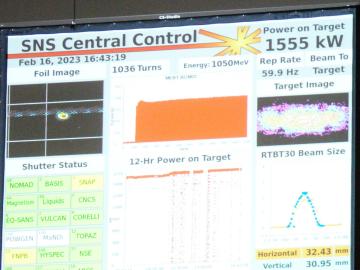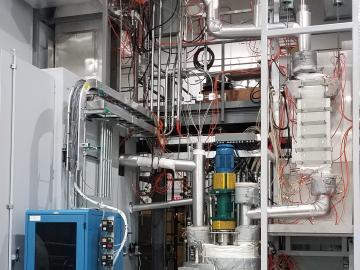Filter News
Area of Research
- Advanced Manufacturing (2)
- Biological Systems (1)
- Biology and Environment (56)
- Building Technologies (1)
- Clean Energy (64)
- Computational Engineering (1)
- Computer Science (2)
- Electricity and Smart Grid (1)
- Energy Sciences (1)
- Fuel Cycle Science and Technology (1)
- Fusion and Fission (20)
- Fusion Energy (3)
- Isotope Development and Production (1)
- Isotopes (16)
- Materials (78)
- Materials Characterization (2)
- Materials Under Extremes (1)
- National Security (28)
- Neutron Science (33)
- Nuclear Science and Technology (2)
- Supercomputing (73)
Date
News Topics
- 3-D Printing/Advanced Manufacturing (30)
- Advanced Reactors (6)
- Artificial Intelligence (48)
- Big Data (17)
- Bioenergy (32)
- Biology (40)
- Biomedical (12)
- Biotechnology (11)
- Buildings (27)
- Chemical Sciences (35)
- Clean Water (8)
- Climate Change (50)
- Composites (10)
- Computer Science (39)
- Coronavirus (4)
- Critical Materials (9)
- Cybersecurity (9)
- Decarbonization (49)
- Education (4)
- Emergency (2)
- Energy Storage (29)
- Environment (61)
- Exascale Computing (20)
- Fossil Energy (4)
- Frontier (25)
- Fusion (13)
- Grid (21)
- High-Performance Computing (46)
- Hydropower (3)
- Irradiation (2)
- Isotopes (20)
- ITER (1)
- Machine Learning (23)
- Materials (72)
- Materials Science (28)
- Mathematics (4)
- Mercury (2)
- Microelectronics (2)
- Microscopy (9)
- Molten Salt (1)
- Nanotechnology (9)
- National Security (34)
- Net Zero (10)
- Neutron Science (41)
- Nuclear Energy (27)
- Partnerships (33)
- Physics (16)
- Polymers (9)
- Quantum Computing (20)
- Quantum Science (19)
- Renewable Energy (2)
- Security (5)
- Simulation (40)
- Software (1)
- Space Exploration (7)
- Statistics (2)
- Summit (13)
- Sustainable Energy (32)
- Transportation (28)
Media Contacts

Environmental scientists at ORNL have recently expanded collaborations with minority-serving institutions and historically Black colleges and universities across the nation to broaden the experiences and skills of student scientists while bringing fresh insights to the national lab’s missions.

Warming a crystal of the mineral fresnoite, ORNL scientists discovered that excitations called phasons carried heat three times farther and faster than phonons, the excitations that usually carry heat through a material.

ORNL's Spallation Neutron Source set a world record when its linear accelerator reached an operating power of 1.55 megawatts, which improves on the facility’s original design capability.

ORNL staff members played prominent roles in reports that won one Distinction award and two Excellence awards in the 2022 Alliance Competition of the Society for Technical Communication. PSD's Karren More and Bruce Moyer participated.

Natural gas furnaces not only heat your home, they also produce a lot of pollution. Even modern high-efficiency condensing furnaces produce significant amounts of corrosive acidic condensation and unhealthy levels of nitrogen oxides

Oak Ridge National Laboratory scientists set out to address one of the biggest uncertainties about how carbon-rich permafrost will respond to gradual sinking of the land surface as temperatures rise.

When aging vehicle batteries lack the juice to power your car anymore, they may still hold energy. Yet it’s tough to find new uses for lithium-ion batteries with different makers, ages and sizes. A solution is urgently needed because battery recycling options are scarce.

Oak Ridge National Laboratory researchers demonstrated that window shades with a cellular or honeycomb structure provide higher energy savings during winter compared to generic venetian blinds and can save millions of tons of carbon emissions.

Scientists at ORNL have begun operating a unique system designed to enable a variety of testing to characterize the performance of an advanced heat transfer fluid for renewable energy

With larger, purer shipments on a more frequent basis, Oak Ridge National Laboratory is moving closer to routine production of promethium-147. That’s thanks in part to the application of some specific research performed a decade ago for a completely different project.




